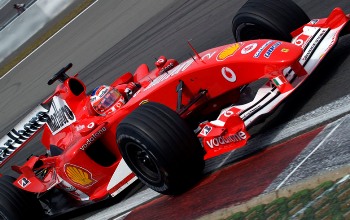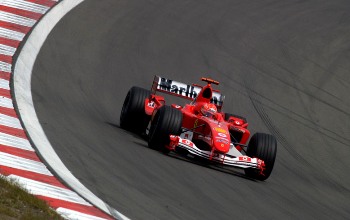|
The European
Grand Prix used to move around, taking place at a variety of
circuits, but it has had an almost permanent home at the
Nürburgring, which has hosted this race nine times,
including every year since 1997, except that in ’97 and ’98,
just to confuse things, it was known as the Luxembourg GP.
Although the
current circuit has been in use for over two decades, it is
still referred to as the 'New ‘Ring' by those who remember
the daunting 22 kilometres of the old Nordschleife track,
that was eventually deemed too dangerous for modern grand
prix cars.
At about the
same time that the antiquated track was pensioned off,
Dieter Gundel was beginning his motor racing career, working
in electronics. Today he is Head of Electronics at the race
tracks for Scuderia Ferrari Marlboro.
“Twenty years
ago, electronics was just beginning to become the “hot item”
in motor racing,” says the German. “Ever since then it has
developed from something that is quite useful and gives a
little bit of an advantage into an element that is
absolutely essential. Without electronics, nothing turns,
nothing blinks, nothing does anything.”
Progress on
electronics was slow until the advent of the computer and
the first advantages seen on the cars were chiefly in terms
of providing increased power. “We have to admit that the
original ideas came from road cars and it is not a case of
motor racing leading the development,” continues Gundel.
“The most obvious change was the switch from putting fuel in
the engine with a carburettor to using fuel injection. It
gave far greater control and allowed you to adjust more
parameters.”
The other
element that moved electronic development forward was the
arrival of the turbocharged engines in the 80s. The
turbocharger was quite a delicate piece of equipment and
needed more accurate control, for elements such as the
waste-gate. “This is how electronics muscled its way into
the sport,” recalls Gundel. “We had so much electronics it
was a case of picking the area that gave the biggest
advantage and of course one team would come up with
something and the others would follow. Technology has moved
at a rapid rate. If you compare the power of calculation we
have on the car nowadays with that of twenty years ago, you
could not run a small computer game for kids with the power
we had on the cars back then!”
Once the miracle
of electronics had reached a point where it was taken for
granted, the specialists in this field came under ever
increasing pressure to come up with ever more sophisticated
systems that were smaller, lighter and more resistant to
vibration and especially to heat.
“The amount of
wiring on the car has decreased significantly over the
years,” says Gundel. “For example, we now use copper wires
that are no thicker than a human hair for sensors for
example. The wiring per metre is a fraction of what we had.
We use more intelligent sensors that now communicate via
digital signals, which is another technology that has come
from road cars.
|
 |
|
Last
year at the Nurburgring Rubens Barrichello followed
home his team-mate Schumacher to give Ferrari a 1-2
finish |
|
|
 |
|
At last year's European
Grand Prix, Michael Schumacher (above) claimed his
sixth victory out of the first seven races of the
season, dominating after starting from
pole position |
|
|
"The hardware side has reduced in weight and
size and technology means our experience has grown. In the
past we used military connectors from tanks and airplanes,
built to last for 5 years of use. It was good for F1 because
not even we could break them. But if I came today with one
of these connectors and showed it to (Chief Designer) Rory
Byrne he would have a heart attack!
Today,
electronics is used in every aspect of the car, but its most
obvious use is in running the engine. “You have to inject
fuel and you have to fire the spark,” maintains Gundel. “But
on top of this is all the diagnostic monitoring, the back up
systems and pumps. The diagnostic side has become far more
important this year with engines having to last two race
weekends. We might have more than 20 sensors on the engine
for diagnostics alone, apart from those used to actually run
the engine. To be honest, for us here at Ferrari, this was
not such a big change from the past, as we already had a
fantastic record of reliability and that was partly down to
our monitoring systems.”
The new rules,
with the cars staying in parc ferme in between qualifying
and the race, has also made the role of electronics more
important, as software changes are one of the few areas that
can be worked on. “Apart from the engine, other areas where
we can tune for performance using electronics are traction
control, engine braking and differential performance. These
are the only legal areas where we are allowed to work,”
explains Gundel. “While the car is in parc ferme, we have
the model of our strategies on the computer and we can tune
them and are allowed to upload all our modifications into
the car before the race. Now, we analyse the performance of
our cars on Friday and Saturday and try to improve areas
that were not perfect, by running simulations. We try to
combine all these tunings to give an overall improvement on
the car without having to run the car. It is not all down to
technology though and you still need to use the human brain.
Sometimes it is our best friend!”
So will this
weekend on home turf at the Nürburgring be a chance for
Gundel to catch up with old friends from his racing past?
“Not really,” he says with a hint of embarrassment. “As a
child I was not at all interested in motor racing and when I
started working with Bosch back in 1985, I stayed in the
laboratory and did not go to the tracks. But when Data
Logging and Telemetry became more common I would go to the
occasional race. At first the racing drivers were very
suspicious of Data Logging and regarded it as a spy system.
Now, the good drivers know they can improve with the help of
the data and they spend a lot of time studying it. But to
get back to the question, no the Nurburgring will not be a
special weekend for me, except that I always find it a bit
disturbing because all the people around me speak German!”
|
|
|
|
![]()
![]()